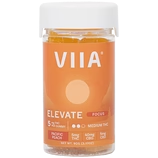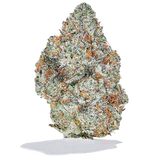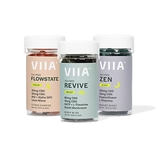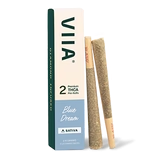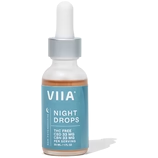
What is CBD? - Everything You Need to Know
What is CBD?
CBD (cannabinol) is a natural compound that comes from the cannabis sativa plant and is known for its potential wellness benefits without the psychoactive “high” associated with THC use.
In this beginner’s guide, we'll explain how CBD works, where it comes from, and how to use it in your daily routine.
The Chemical Structure of CBD and How It Works

CBD's molecular formula is C121H3030O22 , indicating it consists of 21 carbon atoms, 30 hydrogen atoms, and 2 oxygen atoms. Its chemical structure includes a cyclohexene ring, a phenol group, and a pentyl side chain.
This arrangement of atoms contributes to its unique characteristics and interactions with the body's endocannabinoid system (ECS).
CBD is structurally similar to THC. However, there is a critical difference: CBD has a hydroxyl group (-OH) attached to its cyclohexene ring, whereas THC has a cyclic ring structure.
The Chemical Difference Between THC and CBD

This slight difference in their molecular shapes accounts for the distinct effects of these two compounds.
Cannabinoids interact with the endocannabinoid system (ECS) in the human body. The ECS is a complex network of receptors and transmitter chemicals that work together to maintain homeostasis (balance) for systems involved in regulating sleep, mood, hunger, pain perception, and the immune system.
While THC binds directly to the CB1 receptors in the brain, leading to a flood of effects, including its psychoactive potential, CBD doesn't bind directly to these receptors, as its molecular shape isn't a perfect fit.
Instead, researchers believe it interacts with cannabinoid receptors indirectly and modulates their activity. This means that while THC can produce a "high," CBD might offer other health benefits without altering one's mental state [2].
Moreover, CBD's unique structure might allow it to interact with other receptors in the body, such as serotonin receptors, which can influence mood and stress levels, and TRPV1 receptors, which are involved in pain perception and immune responses [3].
Where Does CBD Come From?
CBD and other cannabinoids are naturally produced in the resin glands, also known as trichomes, on the cannabis plant.
If you look closely at a cannabis bud, you'll see these tiny, hair-like crystals that are sticky to the touch. These are essentially the plant's chemical factories, where over a hundred cannabinoids and terpenes are synthesized.
CBD can be extracted from both hemp and marijuana, but most commercially available CBD products come from hemp plants because of their legal status and ease of cultivation for high-CBD and low-THC yields (less than 0.3% by dried weight).

Scientists believe that the cannabis plant naturally produces these cannabinoids and terpenes as a defensive mechanism. In the wild, these compounds help protect the plant from pests, UV rays, and environmental stressors [1].
Potential Benefits of CBD Based on Research
We'll be taking a closer look at CBD's potential applications for wellness, but we want to underscore that this is for educational purposes only.
This information shouldn't be used to self-diagnose or self-medicate with non-prescription CBD products without advice from your healthcare professional.
CBD and Stress
Many people seek out CBD for its potential calming effects. The exact mechanisms for how CBD might help with relaxation aren't fully fleshed out yet, but there are several theories:
- Interaction with serotonin receptors: CBD may interact with 5-HT1A receptors in the brain, which regulate mood and stress levels [4].
- Endocannabinoid system support: One of the well-documented roles of the ECS is regulating stress and mood responses, particularly with an endocannabinoid (internally produced cannabinoid) called anandamide — nicknamed the “bliss molecule.” CBD may help slow the breakdown of anandamide, making it more available in the body and promoting a sense of calm and well-being [5].
- Support brain health: New neuron growth in certain areas of the brain, particularly the hippocampus, is associated with improved mood. CBD may help support the body's process for neurogenesis through its antioxidant potential, protecting cells from environmental and internal stress [6].
CBD and Sleep Support

Many people feel deep mind and body relaxation at higher CBD doses conducive to sleep. Here are several ways CBD may help support healthy sleep patterns:
- Endocannabinoid system support: As mentioned, the ECS influences many key systems, including the sleep-wake cycle. By interacting with cannabinoid receptors, CBD may help balance these cycles, making it easier to fall asleep and stay asleep throughout the night [7].
- Deep relaxation: The body's systems are all interconnected. High levels of stress are often a reason why people can't sleep. CBD's calming effects on the mind may help create a more relaxed state, allowing for an easier sleep drift.
CBD and Discomfort
Although it's not FDA-approved for this either, another popular reason why people seek out CBD products is to support discomfort as part of a pain management plan.
So, how might CBD work to offer some relief?
- Endocannabinoid system support: CBD's interactions with the ECS are the main reason people find the compound useful for maintaining a healthy lifestyle. The ECS is also involved in regulating pain perception and the immune response. By supporting the ECS function, the ECS can protect the body's state of equilibrium. The CB2 receptors, located primarily in the peripheral nervous system, support the body's immune system [8].
- Pain signaling support: Some research suggests that CBD may influence the transmission of pain signals to the brain through TRPV1 receptors, which is one way we interpret pain. It's not the same as blocking the signals altogether, but it does influence intensity [2].
How Are CBD Products Made?
Most CBD products are made from isolating the cannabinoid from the hemp plant. The process involves several steps to ensure consistency of cannabinoid levels in every product batch.
Standard extraction methods include CO2 extraction, which uses carbon dioxide to pull CBD and other beneficial compounds from the plant material, and solvent extraction, which uses alcohol or other solvents.
These methods are designed to preserve the integrity of the cannabinoids and terpenes while removing the larger plant material. The hemp extract is then used to formulate other products, such as gummies, tinctures, vapes, topicals, and more.
Limitations of CBD Products on the Market
If you do a quick Google search on CBD products, you're likely to run into thousands of articles and product pages with outrageous health claims on the myriad of CBD health benefits.
While promising research on CBD's potential exists, it does have limitations, which is why you should approach CBD with a realistic perspective.
CBD isn't a Cure-All
It's not an alternative to pharmaceuticals, especially for serious medical conditions. While some studies and anecdotal evidence suggest that CBD may support overall wellness and help with certain situations, it's not a good idea to rely on CBD as the sole treatment for any severe illness.
Think of CBD as more of a supplement — it may help support your health in various ways, but it can only take you so far without healthy lifestyle choices and medical advice.
Variability in Product Quality
The CBD market is notoriously inconsistent because of a lack of strict regulations.
For instance, some products might contain higher or lower levels of CBD than advertised or, in more serious cases, could be contaminated with harmful substances like pesticides, heavy metals, residual solvents, or mold due to poor manufacturing practices.
This is why it's so important to demand more from CBD companies, such as third-party lab tests that show the purity and concentration of CBD and other active compounds in the products.
Limited Research
CBD and other cannabis compounds have been a growing subject of research, but it's still in the early stages. Most of our evidence comes from animal-based research, small-scale human clinical trials, and surveys.
While the outcomes of these studies have largely been positive, this is only the beginning. Long-term studies will help us better understand its benefits and potential side effects.
How To Use CBD Products: Gummies, Tinctures, Vapes, and Topicals

There's really no one best way to enjoy CBD — the best product for you will depend on your preferences and the type of experience you're after. Here are some of the most popular types of CBD products and how you could add them to your routine.
CBD Gummies and Other Edibles
CBD gummies combine hemp extract with a gummy candy base, which can be applied to chocolate bars, caramels, beverages, or other food. They come in a wide range of CBD concentrations and flavors, making them a popular beginner-friendly option for experimenting with CBD.
When you eat CBD, it passes through the digestive system, where the liver metabolizes it before it enters the bloodstream and ECS. This process might take longer than smoking CBD (typically between 30 and 60 minutes), but the effects tend to last longer.
To use CBD edibles, you'll want to find a product that matches your preferred dose.
If you're new to CBD, start with a lower dose, like a 10 mg gummy. Some people take a low dose daily as an ECS support supplement rather than for immediate relief. But you can increase the dose if you still need to feel the desired effects.
CBD Oil, Tincture, Drops
CBD tinctures are a staple product offering. It combines a set concentration of hemp-derived CBD extract with a carrier oil base (coconut oil, MCT oil, or hemp seed oil).
It's best used sublingually (holding it under the tongue for 30 seconds), which allows some CBD to be absorbed directly into the bloodstream through the mucous membranes in the mouth, bypassing the digestive system for faster effects. Still, you can also mix it into food or drinks.
By measuring your CBD drop by drop, you'll have more control over your dosing, which is handy as some days you might feel like you need a more potent dose than others.
CBD Vapes
Vaping CBD is one of the quickest ways to get the compound into your system. CBD vape products are a broad category on their own, which include vape liquids or disposable vape pens.
Vaping involves heating the CBD extract to a point where it doesn't burn but vaporizes the cannabinoids and terpenes into inhalable smoke, which can be absorbed into the lungs. You can feel the effects within minutes, making it a go-to for those looking for a quick CBD pick-me-up.
CBD Topicals (Creams, Lotions, Balms)
When applied to the skin, CBD interacts with cannabinoid receptors in the skin and underlying tissues, bypassing the bloodstream and digestive system for fast-acting effects without systemic effects.
They're famous for muscle and joint discomfort and in some skincare products. Depending on the concern, they come in various concentrations in formulations.
Traveling with CBD: Can You Fly with CBD?
In the United States, CBD derived from hemp (containing less than 0.3% THC) is federally legal. Domestically, you can generally fly with CBD products containing less than 0.3% THC.
International laws vary significantly, but to stay safe, we don't recommend traveling past US borders with CBD products, even if they're legal in both countries.
CBD Dosages: How Much Should You Take?
There isn't a standard dosage chart for using CBD products, so you can expect it to be a personalized journey, but we can point you to a place to start.
Keep in mind that the dose you might find comfortable can vary individually. Factors like your metabolism, weight, and specific effects you're after can influence your experience with CBD.
Dosage Based on Body Weight
A general guideline for starting with CBD is to take 1-2 mg per 10 pounds of body weight.
- Light Dose:
- 1 mg of CBD per 10 pounds of body weight.
- For a person weighing 150 pounds, a light dose would be 15 mg of CBD.
- For a person weighing 200 pounds, a light dose would be 20 mg of CBD.
- Medium Dose:
- 1.5 mg of CBD per 10 pounds of body weight.
- For a person weighing 150 pounds, a medium dose would be 22.5 mg of CBD.
- For a person weighing 200 pounds, 30 mg of CBD would be a medium dose.
- Strong Dose:
- 2 mg of CBD per 10 pounds of body weight.
- For a person weighing 150 pounds, a strong dose would be 30 mg of CBD.
- For a person weighing 200 pounds, a strong dose would be 40 mg of CBD.
Common advice is to start with a lower dose and work your way up slowly because you can always take more, but taking too much at once can be a recipe for discomfort.
Some people find it helpful to track their CBD intake in a journal or an app on their phone, noting down the dose and how it makes them feel until they find a product and dosage range that best suits their needs.
Risks and Side Effects of CBD
CBD is non-toxic and generally safe for most people, but there are some important safety precautions to be aware of.
Taking too much CBD can result in:
- Dry mouth
- Drowsiness
- Dizziness
- Changes in appetite
- Upset stomach
CBD can also interact with certain medications because it's also metabolized by the liver, affecting a prescription's effectiveness and toxicity, so you must consult with a healthcare professional before combining CBD with your regular medications.
While CBD is not considered addictive and doesn't produce the same dependence issues as THC, it's possible to develop a tolerance over time where you may need to take higher doses to achieve the same effects, which could increase the risk of these side effects.
Is There THC in CBD?
THC levels in CBD products depend on the type of CBD product you're using.
Remember that CBD is extracted primarily by removing the resinous substance from hemp plants, and the resin glands can have many different cannabinoids and terpenes, including THC.
Full-spectrum hemp extracts, sometimes called “whole hemp” products, include a wide range of cannabinoids found in the cannabis plant, including trace amounts of THC.
In the United States, legal full-spectrum CBD products derived from hemp must contain less than 0.3% THC by dry weight. This small amount of THC is not enough to produce psychoactive effects, but it can be detected on a drug test if used in high doses frequently.
For people who want to avoid THC altogether, there are other options.
Broad-spectrum CBD products contain multiple cannabinoids and terpenes but have had all the THC removed. This allows users to benefit from the entourage effect without the presence of THC.
Lastly, CBD isolate is the purest form of CBD, containing 99% or more cannabidiol and no other cannabinoids or terpenes, including THC. It is a good option for people who want to experience a pure CBD experience. However, it may be noticeably weaker in effects than broad-spectrum and full-spectrum products.
Does CBD Show Up on A Drug Test?
Most drug tests screen for THC, not CBD. However, using full-spectrum CBD products can result in a positive test for THC. If you're concerned about drug tests, opt for broad-spectrum or isolate CBD products.
The Takeaway: What is CBD?
Cannabidiol is one of the main active components found in the cannabis sativa plant that can be used in various forms like gummies, tinctures, vape devices, and topicals.
The compound primarily interacts with the body's endocannabinoid system, helping to maintain balance and overall well-being without the psychoactive effects associated with THC.
With CBD's growing popularity, it's important to set realistic expectations about what CBD can and can't do — it's not a cure-all or a substitute for medical treatments. Given that the effectiveness of CBD can vary from person to person, and its benefits and how it works are still being researched, you should be wary of brands that treat CBD like the answer to everything.
CBD offers promising potential as a natural supplement to support various aspects of health and well-being. But it's also important to source your CBD and other dietary supplements from reputable sources that can provide independent lab testing to verify their safety and cannabinoid concentration.
Resources:
- Brousseau, V. D., Wu, B. S., MacPherson, S., Morello, V., & Lefsrud, M. (2021). Cannabinoids and terpenes: how production of photo-protectants can be manipulated to enhance Cannabis sativa L. phytochemistry. Frontiers in Plant Science, 12.
- Corroon, J., & Felice, J. F. (2019). The Endocannabinoid System and its Modulation by Cannabidiol (CBD). Alternative Therapies in Health & Medicine, 25.
- Anand, U., Jones, B., Korchev, Y., Bloom, S. R., Pacchetti, B., Anand, P., & Sodergren, M. H. (2020). CBD effects on TRPV1 signaling pathways in cultured DRG neurons. Journal of Pain Research, 2269-2278.
- Russo, E. B., Burnett, A., Hall, B., & Parker, K. K. (2005). Agonistic properties of cannabidiol at 5-HT1a receptors. Neurochemical research, 30, 1037-1043.
- Hua, D. Y. H., Hindocha, C., Baio, G., Lees, R., Shaban, N., Morgan, C. J., ... & Freeman, T. P. (2023). Effects of cannabidiol on anandamide levels in individuals with cannabis use disorder: findings from a randomised clinical trial for the treatment of cannabis use disorder. Translational Psychiatry, 13(1), 131.
- Maroon, J., & Bost, J. (2018). Review of the neurological benefits of phytocannabinoids. Surgical neurology international, 9.
- Kesner, A. J., & Lovinger, D. M. (2020). Cannabinoids, endocannabinoids and sleep. Frontiers in molecular neuroscience, 13, 125.
- Turcotte, C., Blanchet, M. R., Laviolette, M., & Flamand, N. (2016). The CB 2 receptor and its role as a regulator of inflammation. Cellular and Molecular Life Sciences, 73, 4449-4470.


